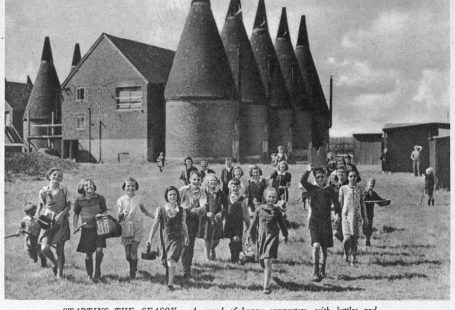As we count down to Christmas here at The Archive, we are delighted to welcome 140,318 brand new pages to our collection, with the addition of three brand new titles over the last seven days.
We have two very special railway titles joining us this week, shining a light on the early days of the railway in the United Kingdom and Ireland and its expansion, as well as a new title which joins us from Northern Ireland. Meanwhile, we have updates to our existing titles from across England, Wales, Ireland and Northern Ireland.
So read on to find out more about our trio of new titles this week, as well as to discover which of our existing titles we have updated, and to learn all about Christmas time at London’s railway stations in 1863, and what type of gifts were being given nearly 160 years ago.
Register now and explore the Archive
First of our duo of specialist railway titles this week is the Railway News, which was first published on 2 January 1864. Describing itself in the early twentieth century as the ‘best known and oldest Railway Journal in existence,’ this title dealt ‘week by week with every topic of interest to the practical and professional man interested in Railway Work,’ with ‘a wide and influential weekly circulation throughout the world.’

The first edition of the Railway News took stock of the social revolution that was the railway, reflecting how:
The social influences of railways are universally recognised. They unite distant parts, and bring town and country closer together. By their means a continuous interchange of persons and property is maintained. They unite the kingdom into a compact whole, and make it more effective for purposes of industry, of action, and of defence…The fuel we burn, the food we eat, the clothes we wear, are all transported by railway from remote parts; the improved means of communication which they present contributing largely to the general comfort, promoting the public welfare and furnishing increased employment for the whole population.
So with the railway revolutionising Britain, connecting its towns and cities with its countryside, providing fuel and food, what did the new publication hope to achieve? Well, the Railway News wanted to be a platform for those with an interest in the railways, whether financial or not, for the layman and the specialist, its first edition describing how:
Such is the Interest in its various relations which will form the principal topic of discussion in the Railway News. The conductors believe that there exists a wide range of subjects of a cognate character, relating to railways and their working, well worthy of free ventilation; and they venture to hope that they will be enabled to present in the columns of this Paper, not only an efficient vehicle of intercommunication on subjects of importance to railway men and to railway proprietors, but to the public, for whose accommodation railways have been designed and are constructed.

Appearing for the benefit of all, therefore, as the railways did too, the Railway News was published every Saturday. It was initially titled the Railway News and Joint Stock Journal, and consisted of 24 pages, costing six pence. It contained ‘articles on the details of railway working, and information as to weekly traffics, prices of stocks and shares,’ looking at railway interests across the world. For example, its debut edition featured articles on ‘The Projected Metropolitan Lines,’ ‘The Grand Trune Railway of Canada,’ and ‘The Charing-Cross Railway,’ as well as looks at meetings of railway shareholders, ‘Projected Railway Schemes,’ and ‘Railway Revenue Accounts.’
The Railway News also contained details of weekly railway traffic returns, as well as a variety of advertisements for worldwide railway companies, including the Ottoman Railway, the Great Luxembourg Company and the Great Eastern Railway.
By the early twentieth century, the Railway News had expanded to span over 50 pages, featuring detailed diagrams and illustrations alongside articles addressing ‘Electrical Railways’ and railway building in Australia. It also contained an exhaustive ‘Buyers’ Directory of Ads,’ as well as portraits of ‘Railway Directors & Staff,’ as well as photographs of those ‘railwaymen’ who had been recognised in the New Year’s Honours.

We have added over 100,000 pages to this very special title this week, which span the years 1864 to 1918.
Preceding the Railway News by nearly 30 years was Herapath’s Railway Journal, which was established in 1835, in the very early days of the railway boom. Initially known as The Railway Magazine and Annals of Science, the publication appeared in journal form, and was edited by John Herapath (1790-1868), who would eventually lend his name to the title from 1841 onwards.

Herapath was an English physicist, and with his role as editor of the Railway Magazine, he was able to publish his scientific ideas. Indeed, Herapath’s Railway Journal was initially devoted to both the interests of the railway and science, containing reports from the various railway companies across Britain, such as the Liverpool and Manchester Railway, the Edinburgh and Glasgow Railway, and the London and Birmingham Railway, as well as updates on various scientific matters, including a look at ‘British Scientific Intelligence’ and a ‘Mechanical Section.’
Meanwhile, early iterations of Herapath’s Railway Journal contained book reviews, a look at ‘parliamentary proceedings,’ and the price of railway shares. By the 1840s the publication had slimmed down, from 100 pages to 20, and had changed its name in honour of its editor, devoting itself to ‘railway and kindred interests,’ showcasing ‘Railway, Commercial, and Financial Intelligence.’

Appearing every Saturday at the cost of five pence, Herapath’s Railway Journal contained the ‘Times of Starting of All Railway Trains,’ as well as the prices of railway shares and a look at parliamentary matters affecting the railways. It also featured reports on accidents on the railways, as well as the latest from railway shareholder meetings, the opening of new railways, and correspondence regarding a plethora of railway topics.
Herapath’s Railway Journal continues to be published to this day as monthly business magazine Railway Gazette International, which is read in 140 countries and looks at railway, metro, light rail and tram industries.
Our final new title of the week is Witness (Belfast), a Presbyterian title which was first published on 3 January 1874 and circulated ‘in Ulster and Ireland generally.’ Spanning eight pages and costing just one penny, Witness (Belfast) stepped onto the publishing scene with noble intentions, not only hoping to be a ‘useful family intelligencer,’ but to:
…be a teacher as well as a newsmonger. We mean to communicate instruction as well as intelligence. We hope to profit as well as to please.
In religious matters, the Presbyterian title promised to be ‘both secular and sacred, civil and ecclesiastical,’ representing a ‘union of church and state.’

So what did the pages of Witness (Belfast) contain? Well, it featured ‘General News’ from across Ireland, Britain and the rest of the world, as well as poetry, a ‘Corner for the Little Ones’ and notices of births, marriages and deaths. In keeping with the newspaper being a religious one, it contained ‘Biographical Sketches of the Irish Presbyterian Worthies,’ news from churches of various denominations, as well as a look at ‘Scripture Difficulties.’
Well, that’s it from our trio of new titles this week. Meanwhile, we have updated nine of our existing titles, with updates to the Carmarthen Journal, the Cork Weekly News, the Liverpool Journal of Commerce and the Ulster Echo for you to explore.
Christmastime on the Railways
When the Railway News first appeared in early January 1864, it looked back at ‘The Christmas Railway Traffic in London,’ writing how:
Of the many sights which at the present season of the year possess a special interest, there are few, if any, of a more remarkable character, or which deserve to be regarded with greater favour by the readers of this journal, and by all persons interested in the great railway undertakings, than the metropolitan stations during the Christmas week.

It goes on to set the scene at the ‘departure platform of the London and North-Western Railway,’ at Euston Station. The time midnight, just before Christmas:
A large place near the platform is lighted with a hundred lamps, and some fifty porters are shouting and jostling, and throwing to the right and left packages of all shapes and sizes. Enter this strange place, and you will see that there are little short of ten thousand parcels and packages which have to be distributed and despatched to their destinations.
It is here that Christmas parcels arrive into London, and are dispatched from the capital:
Hampers and baskets of all shapes, barrels, and sacks, wooden cases, everything that can be held together by rope, or twine, or nails, or hoops, is brought into requisition, in town and country, to convey some substantial compliments of the season to a distant friend.

But what were people gifting each other for Christmas in 1863? The Railway News describes the assembled presents as a ‘vast and motley bulk,’ given by people of all different classes, and ages, and how:
The game from the aristocratic preserves jostles with the basket of apples and the home-made loaf or cake which the small farmer has sent up to his son to remind him of the days of his boyhood, and the orchard in which he wandered ere he entered the merchant’s office in the great City of London; the haunch of venison of the red deer from Sutherlandshire lies by the side of home-dried bacon from the Shropshire yeoman to his brother in the drapery trade in the Tottenham-court-road; there are the legs and quarters of sheep from the mountains of North Wales, and the pies from Melton Mowbray; and as these come into London, there leave the great city the hundreds of barrels of oysters and the accompanying cod fish from the Sweetings, and the Pims, and the Prossers; cakes from Pursell’s; barrels of ale from Bass and Allsopp; and hampers of wine from no end of the wine-merchants of London.
We can see that the presents exchanged in 1863 were mainly of a food or drink variety, indeed, all of the gifts described are ones that could be eaten or drunk. Meanwhile, the Railway News tells us that 27,000 parcels were sent from Euston during the Christmas week, whilst 17,000 were received there. Indeed, during the past twenty years parcels carried by the London and North Western Railway had more than doubled; from 570,000 during the whole year of 1843, to a projected 1,200,000 in 1863.

Other London railway stations were also busy sending and receiving parcels, as well as carrying more passengers over the festive season. Paddington was one of these stations, where:
The parcels and the contents are generally similar to those of the London and North-Western; but in the case of the traffic; game, especially pheasants, is sent to London from the western districts; there is a good supply of fish from Bristol and Gloucester, and a tolerably large quantity of mutton from Wales. The passenger traffic upon the Great Western was very large in amount, the receipts at the Paddington Station alone showing an increase of £1,200 over the corresponding week of the last year.
Meanwhile, at London Liverpool Street, Mr. Moseley, the superintendent of traffic, gave this very exact list of the ‘Christmas fare delivered at the London station of the Great Eastern Railway, from the 15th to the 24th December:’
Oxen, 1,328; sheep, 3,747; calves, 62; pigs, 736; turkeys, 12,812; geese, 16,922; ducks, 630; hares and pheasants, 1,016; sacks of flour, 13,076; kilderkins, hogsheads, and barrels of beer, 9,622; boxes of oranges, 1,010; boxes of dried fruit, 3,023; bags of nuts, 566; barrels of oysters, 47 tons; boxes of almonds, 308; sacks of potatoes, 9,399; meat, packed in hampers, 391 tons; poultry, 374 tons; fish, 441 tons; milk, 76,831 quarts, Stilton, and other choice cheese, 1,317.

We love this wonderfully precise insight into what was coming into London at Christmas time. And the Railway News also relates how:
This year there is not a single instance of a parcel from London without a legible and correct address, and only three cases of an opposite character have occurred in the country parcels, with the exception of three misdirected ones from the country, and a hare, a goose, and a turkey are still adrift at the station.
We hope that the hare, goose and turkey didn’t go to waste!
And so, the Railway News gave its readers ‘some notion of the additional amount of work which, at the Christmas season, is performed by the railways, and of the benefits of which, in a social point of view, they confer upon the public at large.’ Meanwhile, the newspaper gives us a wonderful snapshot of a Victorian Christmas, the gifts that people sent each other across the country, and how they were conveyed by the most revolutionary method of transport of the era: the railway.
Now, all that is left for us is to wish all our readers and subscribers a very merry Christmas, and we hope you enjoy browsing the pages of the Railway News as much as we have done.
New Titles
Title |
Years Added |
| Herapath’s Railway Journal | 1838-1843 |
| Railway News | 1864-1918 |
| Witness (Belfast) | 1874-1880, 1883-1896 |
Updated Titles
This week we have updated nine of our existing titles.
You can learn more about each of the titles we add to every week by clicking on their names. On each paper’s title page, you can read a FREE sample issue, learn more about our current holdings, and our plans for digitisation.
Title |
Years Added |
| Carmarthen Journal | 1980 |
| Cork Weekly News | 1903, 1905, 1908-1909, 1913, 1920 |
| Hinckley News | 1878, 1885 |
| Hucknall Morning Star and Advertiser | 1903 |
| Kerry People | 1903 |
| Liverpool Journal of Commerce | 1901 |
| Newark Advertiser | 1904 |
| South Gloucestershire Gazette | 1933 |
| Ulster Echo | 1875, 1880-1881, 1885-1886, 1890, 1897, 1902 |
You can keep up to date with all the latest additions by visiting the recently added page. You can even look ahead to see what we’re going to add tomorrow.






